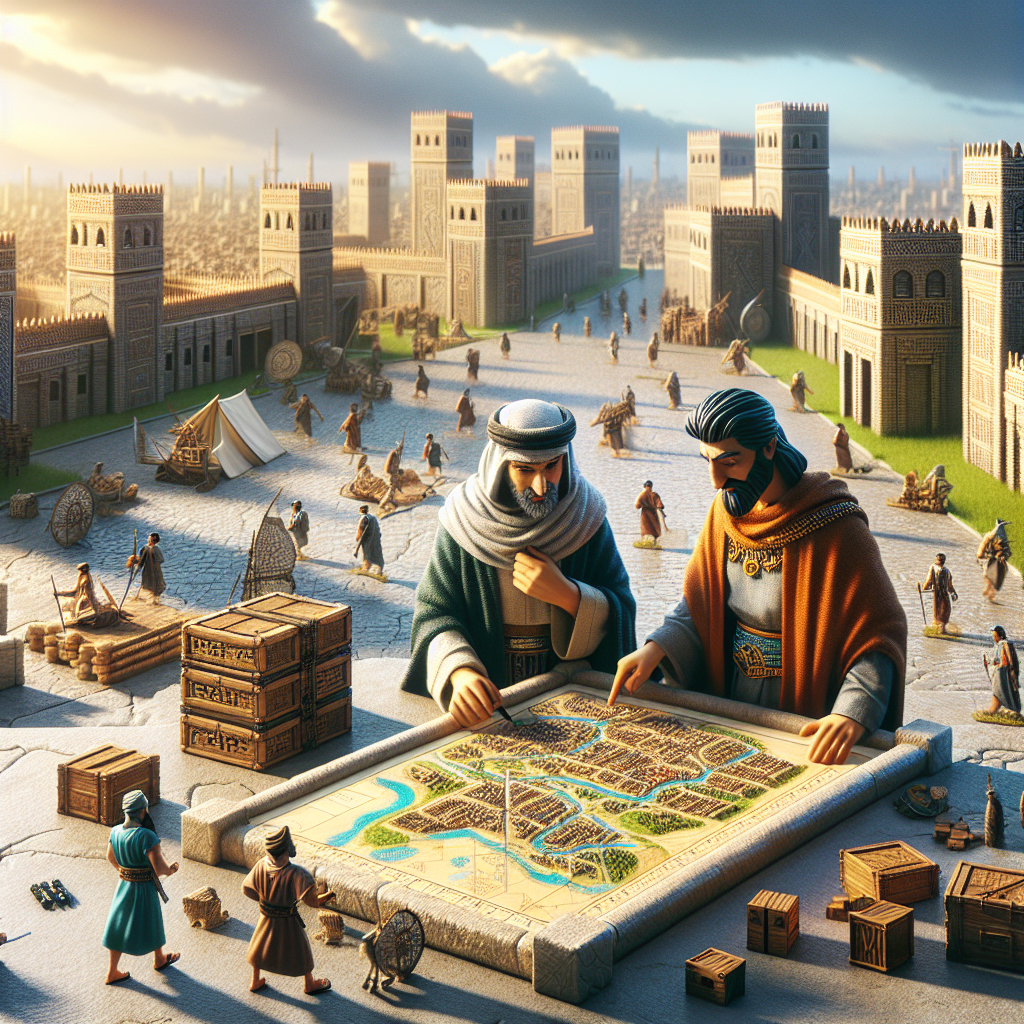“Forge of Empires” is a strategic online game developed by InnoGames, where players build and expand their own city from the Stone Age through various historical periods. Version 4.1 of the game introduces enhanced gameplay mechanics, improved graphics, and new features that enrich the player experience. Players must manage resources, develop technologies, and engage in tactical battles to grow their empire and compete with others. The game combines city-building elements with strategic planning, offering a deep and engaging experience for fans of the genre.
Mastering City Planning in Forge of Empires: Tips and Tricks
Mastering city planning in Forge of Empires requires a strategic mindset and a keen understanding of the game’s mechanics. As players progress through different ages, the complexity of managing resources, space, and time increases. Therefore, it is essential to adopt a methodical approach to city planning to ensure efficient growth and development. This article aims to provide valuable tips and tricks to help players optimize their city layouts and maximize their potential in Forge of Empires.
To begin with, one of the fundamental aspects of city planning is the efficient use of space. In Forge of Empires, space is a limited resource, and players must make the most of every available tile. It is advisable to prioritize the placement of essential buildings such as residential houses, production facilities, and cultural buildings. Residential houses generate population, which is crucial for unlocking new buildings and technologies. Production facilities, on the other hand, provide the necessary resources to sustain the city’s growth. Cultural buildings enhance the happiness of the population, which in turn boosts productivity. By strategically placing these buildings, players can create a well-balanced city that thrives on efficiency.
Another critical factor in city planning is the management of roads. Roads are necessary for connecting buildings and ensuring the smooth flow of resources and services. However, excessive road placement can consume valuable space that could otherwise be used for buildings. To optimize road usage, players should aim to create a compact and interconnected road network. This can be achieved by placing buildings in clusters and minimizing the distance between them. Additionally, players should consider the placement of key buildings such as Town Halls and Great Buildings, as these structures often require direct road access. By carefully planning the road layout, players can maximize the available space and enhance the overall efficiency of their city.
In addition to space management, resource management is another crucial aspect of city planning. Players must ensure a steady supply of resources such as coins, supplies, and goods to support their city’s growth. To achieve this, it is essential to maintain a balanced production chain. Players should focus on building a mix of production facilities that generate different types of resources. For example, having a combination of coin-producing houses and supply-generating workshops can help maintain a steady flow of resources. Furthermore, players should regularly upgrade their production facilities to increase their output and efficiency. By maintaining a balanced production chain, players can ensure a consistent supply of resources and avoid bottlenecks in their city’s development.
Moreover, players should pay attention to the placement of special buildings such as Great Buildings and event buildings. These structures often provide unique bonuses and benefits that can significantly enhance the city’s performance. However, they also require careful placement to maximize their impact. For instance, some Great Buildings provide bonuses to adjacent buildings, making it essential to place them in strategic locations. Similarly, event buildings often have specific requirements and bonuses that can influence their placement. By strategically placing these special buildings, players can leverage their benefits to boost their city’s growth and efficiency.
Lastly, players should regularly review and adjust their city layout as they progress through different ages. As new buildings and technologies become available, players may need to reconfigure their city to accommodate these changes. This may involve relocating buildings, upgrading roads, or even demolishing outdated structures. By continuously optimizing their city layout, players can ensure that their city remains efficient and well-organized.
In conclusion, mastering city planning in Forge of Empires requires a strategic approach and careful consideration of various factors such as space management, road layout, resource management, and the placement of special buildings. By following these tips and tricks, players can create a well-balanced and efficient city that thrives on growth and development.
Advanced Battle Strategies for Forge of Empires Players

In the ever-evolving world of Forge of Empires, mastering advanced battle strategies is crucial for players aiming to dominate their opponents and expand their empires. As the game progresses, the complexity of battles increases, requiring players to adopt more sophisticated tactics. Understanding the nuances of unit types, terrain advantages, and strategic positioning can significantly enhance a player’s ability to win battles and secure valuable resources.
To begin with, a comprehensive understanding of the various unit types is essential. Each unit in Forge of Empires has unique strengths and weaknesses, which can be leveraged to gain an upper hand in combat. For instance, light units are highly mobile and effective against ranged units, but they are vulnerable to heavy units. Conversely, heavy units boast high defense and can withstand significant damage, making them ideal for absorbing enemy attacks. Ranged units, on the other hand, can deal substantial damage from a distance but are susceptible to close-range assaults. By carefully selecting a balanced mix of units, players can create versatile armies capable of adapting to different combat scenarios.
In addition to unit selection, terrain plays a pivotal role in battle outcomes. Certain terrains provide defensive bonuses or movement penalties, which can be strategically exploited. For example, forests and hills offer defensive advantages, making them ideal positions for ranged units to launch attacks while remaining protected. Open plains, however, allow for greater mobility, benefiting light units that rely on speed. By positioning units on favorable terrain, players can maximize their defensive capabilities and minimize vulnerabilities.
Moreover, strategic positioning and movement are critical components of advanced battle strategies. Players should aim to control the battlefield by occupying key positions and forcing the enemy into disadvantageous situations. Flanking maneuvers, where units attack from the sides or rear, can disrupt enemy formations and cause significant damage. Additionally, maintaining a cohesive formation ensures that units can support each other, providing mutual protection and enhancing overall combat effectiveness. It is also important to anticipate enemy movements and adjust strategies accordingly, ensuring that units are always in optimal positions to counter threats.
Furthermore, timing and coordination are vital in executing successful battle strategies. Players must carefully plan their attacks, considering the strengths and weaknesses of both their own units and those of the enemy. Coordinated assaults, where multiple units attack simultaneously, can overwhelm opponents and break through their defenses. Conversely, staggered attacks can be used to draw out enemy units and create openings for more decisive strikes. Effective use of special abilities, such as healing or area-of-effect attacks, can also turn the tide of battle when used at critical moments.
Lastly, continuous learning and adaptation are key to mastering advanced battle strategies in Forge of Empires. The game constantly introduces new units, technologies, and challenges, requiring players to stay informed and adjust their tactics accordingly. Analyzing battle outcomes, learning from mistakes, and experimenting with different strategies can provide valuable insights and improve overall performance. Engaging with the community, participating in forums, and watching experienced players can also offer new perspectives and ideas.
In conclusion, advanced battle strategies in Forge of Empires involve a combination of unit selection, terrain utilization, strategic positioning, timing, and continuous adaptation. By mastering these elements, players can enhance their combat effectiveness, secure victories, and expand their empires. As the game evolves, staying informed and flexible will remain essential for achieving long-term success in the dynamic world of Forge of Empires.
Optimizing Resource Management in Forge of Empires
In the intricate world of Forge of Empires, resource management stands as a cornerstone of successful gameplay. As players navigate through various ages, the ability to efficiently manage resources becomes increasingly critical. The latest update, Strategy 4.1, introduces several enhancements aimed at optimizing resource management, thereby enabling players to advance their cities more effectively.
To begin with, understanding the fundamental resources in Forge of Empires is essential. These resources include coins, supplies, goods, and diamonds. Each resource plays a unique role in the development and expansion of a player’s city. Coins and supplies are the most basic resources, used for constructing buildings, training military units, and conducting research. Goods, on the other hand, are crucial for negotiating with other players and advancing through the ages. Diamonds, the premium currency, offer a shortcut to various in-game advantages but are often limited in availability.
One of the key strategies for optimizing resource management is to maintain a balanced production system. Players should ensure that their city has a steady flow of coins and supplies by constructing and upgrading residential and production buildings. It is advisable to prioritize buildings that offer the highest output relative to their space and time requirements. Additionally, players should regularly collect resources to prevent production from halting due to full storage.
Another important aspect of resource management is the efficient use of goods. Goods are produced in specific buildings and are required for various purposes, including negotiating with other players and completing quests. To maximize the production of goods, players should focus on constructing and upgrading goods buildings that are relevant to their current age. Furthermore, trading with other players can be an effective way to acquire the goods needed for advancement. Players should actively participate in their guild’s trading activities and use the market to exchange surplus goods for those in short supply.
The introduction of Strategy 4.1 brings several new features that enhance resource management. One notable addition is the Resource Overview tool, which provides players with a comprehensive view of their resource production and consumption. This tool allows players to identify bottlenecks and adjust their production strategies accordingly. For instance, if a player notices a shortage of supplies, they can prioritize the construction of supply-producing buildings or adjust their collection schedule to optimize output.
Moreover, the update introduces new quests and events that offer valuable rewards, including resources. Players should actively participate in these events to gain additional resources that can be used to accelerate their city’s development. Completing quests not only provides immediate rewards but also contributes to long-term progress by unlocking new buildings and technologies.
In addition to these strategies, players should also consider the strategic use of diamonds. While diamonds can be used to speed up various processes, it is important to use them judiciously. Players should prioritize spending diamonds on critical upgrades or to overcome resource shortages that cannot be addressed through other means. By carefully managing their diamond expenditure, players can ensure that they have sufficient premium currency available for crucial moments in the game.
In conclusion, optimizing resource management in Forge of Empires requires a combination of strategic planning, efficient production, and active participation in in-game activities. The enhancements introduced in Strategy 4.1 provide players with valuable tools and opportunities to refine their resource management strategies. By maintaining a balanced production system, efficiently using goods, and strategically utilizing diamonds, players can ensure the steady growth and advancement of their cities. As players continue to explore the complexities of Forge of Empires, mastering resource management will remain a key factor in achieving long-term success.Forge of Empires by InnoGames is a strategic city-building game that allows players to develop a city from the Stone Age through various historical periods. Version 4.1 introduces enhancements in gameplay mechanics, user interface, and additional content, providing a more immersive and engaging experience for players. The update focuses on refining the strategic elements and expanding the depth of the game, making it a compelling choice for fans of the genre.





